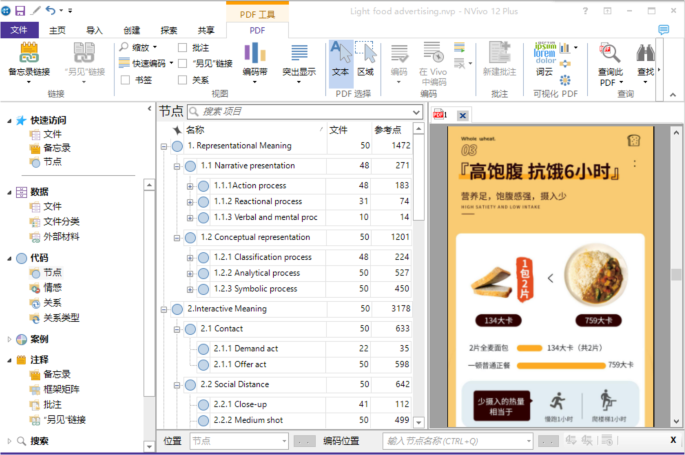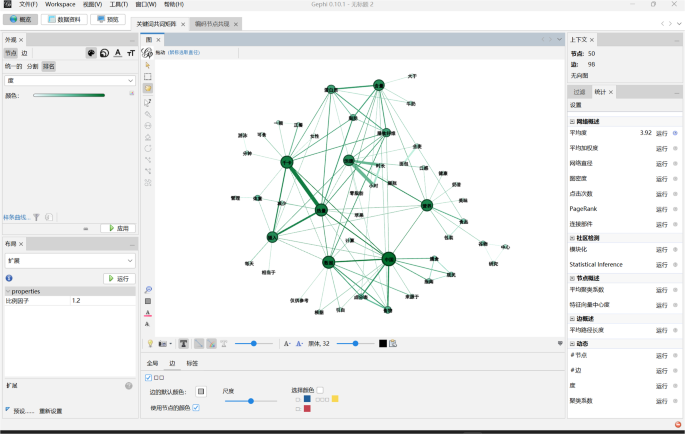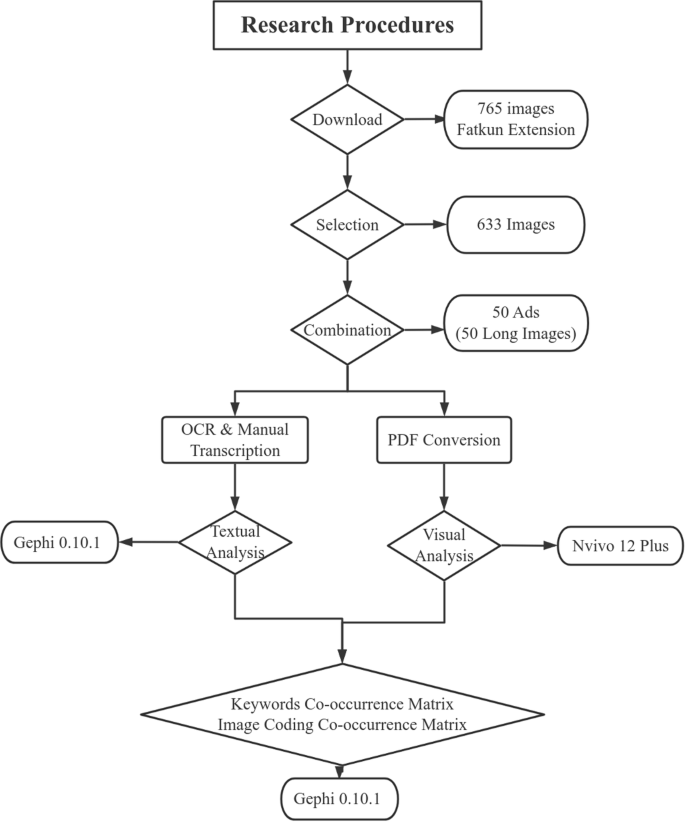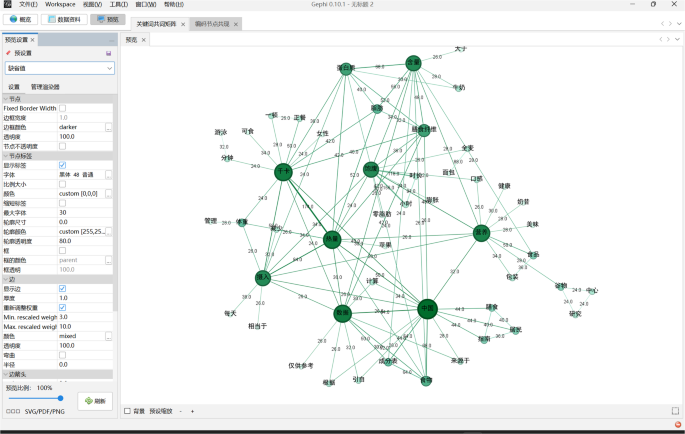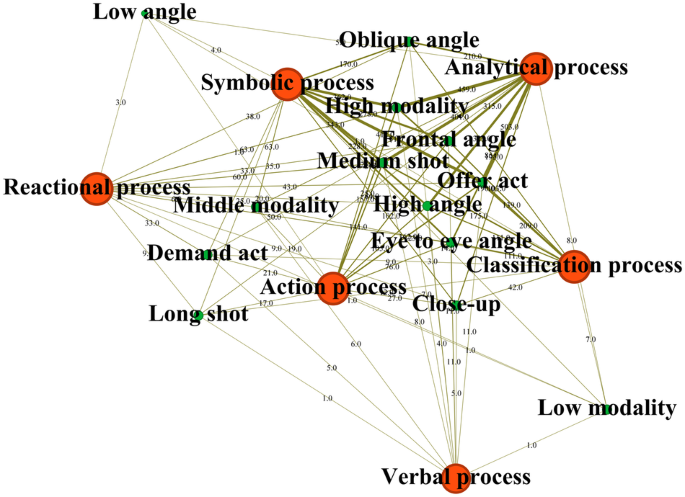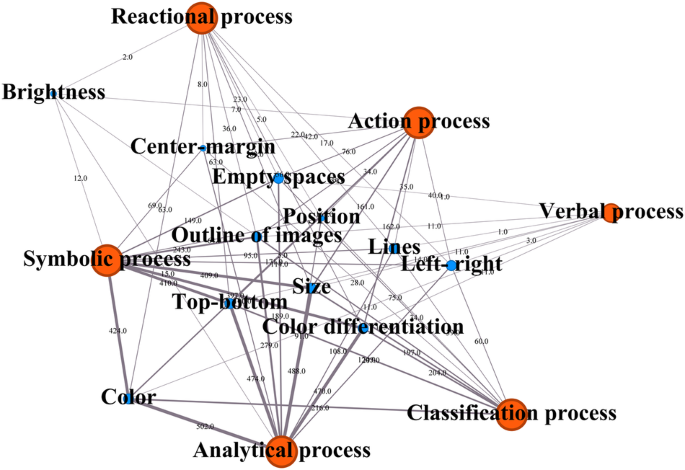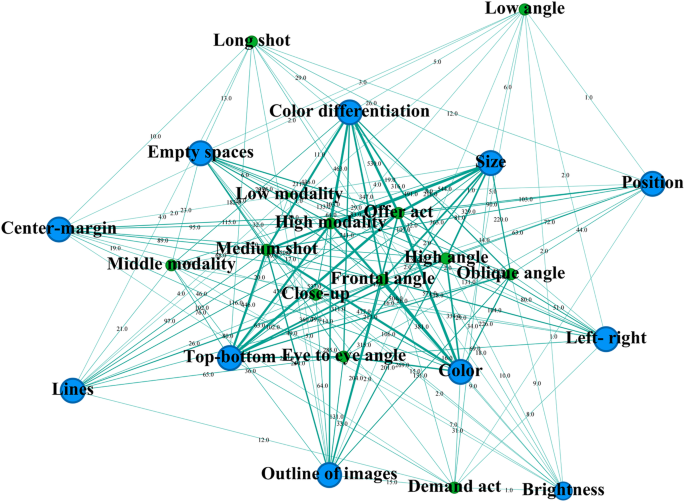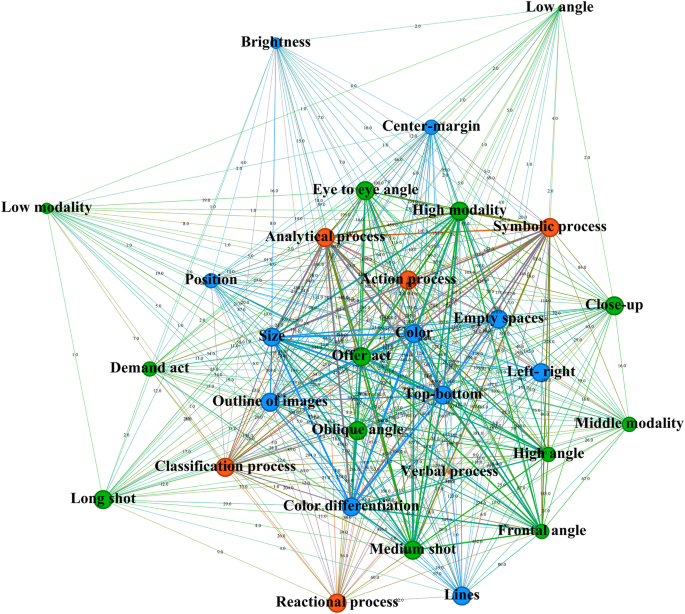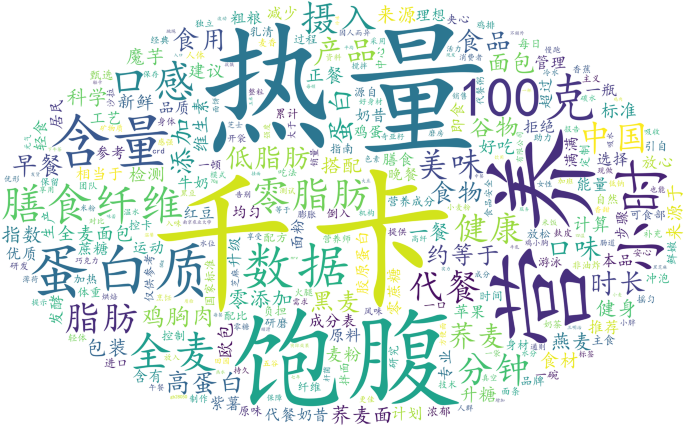Abstract
Amidst global health concerns such as COVID-19 and rising obesity rates, the connection between food choices, societal well-being, and cultural shifts has gained attention. In China, the rise of “light food” consumption on platforms like Taobao reflects a growing trend towards health-conscious dietary preferences. With a dataset comprising 633 images and 45,817 words, condensed into 50 images for analysis, this research aims to understand how these advertisements influence perceptions of healthiness and desirability, and whether there is a discrepancy between advertised health benefits and actual nutritional content. This study delves into the advertising strategies employed for light food products on the Taobao platform in China, utilizing a Textual–Visual Thematic Analysis (TVTA) framework. Noteworthy findings include: (1) Internet-based light food advertising adopts a dual textual and visual approach. (2) Identification of prevalent multimodal devices, such as medium shots, varied camera angles, vibrant colors, and large size. (3) Uncovering inconsistencies in presentation that may pose potential consumer misperceptions. These discoveries underscore the nuanced landscape of light food advertising, offering valuable insights for both academia and industry.
Similar content being viewed by others
Introduction
The twenty-first century, the age of information, has witnessed stupendous growth in mass media, multimedia and multimodal communications sweeping across the world. And focusing on a single language mode seems incongruous in our technical age, girdled with semiotic modes to meet diverse communicative needs. “Advertising is perhaps the most remarkable mass medium of our age” (Baudrillard, 1998, p. 125). The prosperity of it has also reverberated and even changed people’s understanding of health and beauty. Some scholars have recognized that food advertisements can influence people’s perception of healthiness and preference for foods and habits of diet (Seale, 2002; Gunter, 2016; Eriksson and Machin, 2020), such as genetically modified foods (Roe and Teisl, 2007), organic foods (Kareklas et al., 2014), food targeting on adults (Vukmirovic, 2015; Fang, 2022) and children (Story and French, 2004; Hawkes, 2005; Livingstone, 2006; Moore and Rideout, 2007; Gunter, 2016).
The well-being of individuals is a clear indicator of a country’s success and there is now a significant focus on maintaining good health due to the increasing spread of infectious diseases like COVID-19 and illnesses related to obesity worldwide. For a while now, there has been a debate about how food can impact society, with its effects being reflected in areas such as politics, economy, cultural diversity, and human health (Pilcher, 2017). That’s why the issue of a healthy diet has gained a high political profile in many countries (Slavin, 2015), such as “Healthy China 2030 Initiatives” in China. In recent times, there has been a strong emphasis on the consumption of nutritious food, as it is believed to improve health and aid in weight loss (Chen and Eriksson, 2019; Eriksson and Machin, 2020; Ho, 2020; Montefrio and Wilk, 2020; Machin and Chen, 2023). At the same time, the rise of the obsession with a “thin culture” also entices more people to join the groups for weight loss and fitness. Reducing calorie intake effortlessly through diet has also become one of the sought-after methods to get in shape. Against the backdrop that food, health and beauty are closely entwined, people aspire after the way to a healthy diet and, in turn, get the perfect shape at a seemingly low cost. This trend is particularly apparent in China, where there is a growing interest in “light food” that promotes the idea of becoming a better person through healthy eating (Fang, 2022). And online shopping platforms are honeycombed with advertising hype about what is sold as “healthy” and “good.” This kind of food has emerged with new characteristics in China, which can reflect value and beliefs preferred in contemporary society.
This study focuses on advertising for light food products on the Amazon-like Taobao platform in China in response to the growing popularity of these products, the increasing emphasis on achieving an ideal body shape through diet, and the influential status of Taobao platform. It attempts to investigate light food advertising in a framework of Textual–Visual Thematic Analysis (TVTA) to collaboratively analyze the textual and visual data in the study.
About the framing: TVTA
Essentially, in today’s world of advanced technology and various forms of communication, relying solely on single-mode discourse analysis is inadequate. Multimodal discourses, such as images, videos, and gestures, are crucial for conveying information, participating in social activities, constructing knowledge, and understanding reality. One key author who has contributed to this area is Kress and van Leeuwen (1996, 2001, 2006), who develop the classic theory of Visual Grammar (VG) and highlights the different modes of communication through representational meaning, interactive meaning and compositional meaning. Despite of its groundbreaking achievements in the field of multimodality analysis (MDA), it is still devoid of adequate exploration of intentions behind the visual designation. On this basis, recent years have seen a critical turn from MDA to Multimodal Critical Discourse Analysis (MCDA) to further explain the intention behind semiotic resources chosen to convey meaning (Machin and Mayr, 2012; Machin, 2013; Hart, 2016; Pan and Zheng, 2018; Tian and Pan, 2018). Machin and Mayr (2012, p. 6–10) first proposed the notion of it: “Multimodal Critical Discourse Analysis (MCDA)” that offers a set of tools for the study of visual choices and their features just like the way Critical Discourse Analysis (CDA) does on lexical and grammatical choices textually. The ultimate agenda of it is to identify and unveil buried ideologies and power relations (Machin, 2013; Abousnnouga and Machin, 2013; Machin, 2016; Tian and Pan, 2018) under the guise of seemingly natural, normal or neutral discourse choices like photographs, images, diagrams, graphics and other visual aids through a detailed description. Some attempts of application emerge, such as studies teasing apart basic theoretical concepts and scope of study (Machin and Mayr, 2012; Machin, 2013; Ledin and Machin, 2015; Machin, 2016; Ledin and Machin, 2018) and various targets explorations of media representations of crime (Mayr and Machin, 2012), war monuments (Abousnnouga and Machin, 2013) and food commercials about moral eating (Chen and Eriksson, 2019; Eriksson and Machin, 2020), cultural contexts in the Asia Pacific nations (Montefrio and Wilk, 2020) and cosmopolitan locavorism in Hongkong (Ho, 2020). At this point, the majority of them understood that examining cultural phenomena requires consideration of both visual and textual elements. However, they only applied textual analysis to their visual research or focused on them in a disproportional manner. In essence, they have yet to integrate both visual and textual analysis.
As a specific application of MDA, TVTA is more concerned with identifying and interpreting specific themes and meanings that are conveyed through different modes of textual and visual arrangements that contribute to their construction. According to Braun and Clarke (2006), textual visual thematic analysis involves the systematic coding and categorization of data into themes, which are then interpreted in relation to the research questions and existing literature. Numerous researchers have employed TVTA in diverse settings, including a psychological investigation by Trombet and Cox (2022), feedback provision in design studio by Mayson et al. (2009), and examination of German news coverage of COVID-19 by Xu et al. (2022). As for visual part, visual grammar proposed by Kress and van Leeuwen (1996, 2006) is in the center of discussion. It is concerned about representational meaning, interactive meaning and compositional meaning.
Despite its usefulness, TVTA has some limitations that researchers should be aware of. One limitation is the subjectivity of interpretation which can lead to different interpretations of the same data. Considering the potential risk, we choose to assess the light food advertisements in a structured manner involving qualitative and quantitative analysis. Based on the coded data in Nvivo 12 Plus, the co-occurrence matrix of keywords and visual coding would be depicted in Gephi 0.10.1 to reveal the connections and intentions reflected in light food advertising.
The study
This article addresses the gap in the scholarship by exploring the TVTA devices used in taobao platform to frame the inner association between textual keywords and coding of images with the aid of Social Network Analysis (SNA), to better present the collocation preferences and internal connections contributing to the building of light food image. More specifically, the research questions that guide the present analysis are:
RQ1: What are the most salient visual features of light food advertising on the Taobao platform?
RQ2: What are the predominant textual features observed in light food advertising on the Taobao platform?
RQ3: How do the visual and textual elements of these advertisements interact to construct the image of light foods on Taobao?
Targets
“Light food” means differently to people in countries with different cultural backgrounds and national conditions. In China, we believe that it can be perceived as a new food type online associated with healthy connotations. It refers to an industrial product featuring small amounts, low energy, low calories, low fat, sugar-free, and other similar health-friendly qualities termed “light food labels,” which claims to alleviate people’s intake burden without nutrition loss. It caters to people who want to keep fit or lose weight through diet swiftly and painlessly. Typical products of this kind are food replacing regular meals, sauces, snacks and beverages with “light food labels,” satisfying people’s needs in different stages of health maintenance and beauty attainment. This study focuses on products that replace regular meals on the Taobao platform, which are the most important members of light food and major products purchased by people in the pursuit of perfect shape. These products include five major types: chicken breast, whole wheat bread, meal replacement shakes or porridge, and soba noodles.
Methods
This study employs both qualitative and quantitative research methods to examine light food advertisements on Taobao. Qualitative analysis focuses on interpreting text features through keywords, as well as identifying visual arrangements and generating meaning through VG. Quantitative analysis serves as a complementary tool to provide descriptive statistics on the frequency and distribution of meaning across representational, interactive, and compositional aspects. SNA is also used to visualize the co-occurrence matrix of keywords and visual coding to demonstrate the internal connections among different elements. The co-occurrence matrix is used to visualize the relationships between actors, where the keywords that appear simultaneously tend to have some relevance. The more frequently the keywords appear together, the larger their area of representation and the thicker the line linking keywords will be. Data aside from the line denotes the co-occurrence times among keywords. To systematically evaluate light food advertisements, Nvivo 12 Plus and Gephi 0.10.1 were chosen as analysis tools, as depicted in Figs. 1 and 2. This paper mainly uses Nvivo 12 Plus to code PDF images and export coding co-occurrence data, preparing for the later production of coding co-occurrence matrix. Gephi 0.10.1, an exploration and visualization software widely used in Social Network Analysis, helps identify patterns and connections in network structures. Word co-occurrence matrix is commonly used to visualize relationships between elements that appear simultaneously. In this study, the co-occurrence table of keywords and visual coding will be visualized in Gephi 0.10.1 to unveil connections and intentions reflected in light food advertising.
This figure shows the interface of Nvivo 12 Plus, which is the tool used for image coding of long images through Visual Grammar. This figure is created by Qian Yong, Xiaoqin Rao and is not covered by the Creative Commons Attribution 4.0 International License. Copyright Qian Yong, Xiaoqin Rao, all rights reserved.
This figure shows the interface of Gephi 0.10.1., which is the tool used for generating keywords and visual coding co-occurrence matrix to display the internal connections visually. This figure is created by Qian Yong, Xiaoqin Rao and is not covered by the Creative Commons Attribution 4.0 International License. Copyright Qian Yong, Xiaoqin Rao, all rights reserved.
Data collection
This study follows a specific process for selecting its data. The top 10 selling products in five light food categories on Taobao are chosen, and any repetitive products from the same brand with different prices are removed, resulting in 50 advertisements with a total of 633 images. To ensure representative samples, the chosen brands should exclusively sell light food products. Sales rankings from June 2022 to September 2022 are used to select the top 10 products from each category for three consecutive months, resulting in 150 advertisements. The final research samples of 50 advertisements are chosen from recurring products in each category. The research procedures involve collecting the top 10 products in each category, removing irrelevant images, and combining the remaining 633 images.
The data collection described in Fig. 3 involves several steps. Initially, the top 10 light food products in each category are collected and downloaded in bulk to form the original research focus, consisting of 50 advertisements and a total of 765 scattered images. Following this, irrelevant images such as shipping announcements and nutrition facts are removed, resulting in 633 remaining images that are combined into 50 longer images for ease of management and numbered 1–50. Image character recognition is then performed to obtain a small corpus for text analysis, with expressions uniformly transcribed into Chinese to maintain consistency. The resulting 45,817 words are analyzed through keywords and all advertising is converted to PDF for VG coding through Nvivo 12 Plus. The frequency and distribution of three meta-functions in visual analysis are calculated and listed in tables with detailed interpretation, and the keywords and visual coding co-occurrence are visualized by Gephi 0.10.1 to examine their connections and preferences.
This figure shows the whole procedures of how data is collected and analyzed in detail, including tools adopted in each step. This figure is created by Qian Yong, Xiaoqin Rao and is not covered by the Creative Commons Attribution 4.0 International License. Copyright Qian Yong, Xiaoqin Rao, all rights reserved.
Results and discussions
Textual–visual thematic analysis
Representational meaning: narrative and conceptual
The following text discusses Kress and van Leeuwen’s (2006) framework of representational meaning in visual communication, highlighting two main types: narrative representation and conceptual presentation. It explains that narrative representation focuses on dynamic events and actions, while conceptual presentation emphasizes stable and timeless essences. The key distinguishing factor is the presence of invisible oblique lines denoting direction. The narrative type involves dynamic processes like action, reaction, verbal, and mental processes, while the conceptual type encompasses classification, analytical, and symbolic processes. The analysis also delves into the roles and characteristics of these processes in advertising, emphasizing their influence on viewer perception and understanding. In the present study, this process is commonly used to display detailed information, mainly structured process, and specific features explained in the graph, largely unstructured process, of the products. Speaking of symbolic process, it explains one participant which is largely abstract or general in terms of the other which is specific. The roles involved in this process are carrier, participant whose meaning is established, and symbolic attributes who represents the meaning itself.
Our data in Table 1 reveal that conceptual representation is more prevalent than narrative representation, indicating that marketers of light food products prefer to use this approach for conveying information and promoting their products. In terms of narrative representation, action process is the most commonly used (28.91%), followed by reactional process (11.69%) and verbal process (2.21%). When it comes to conceptual representation, classification process is touched on in 224 images, accounting for 35.39%. Moreover, the most frequently used process types are analytical process and symbolic process, which make up 83.25% and 71.09%, respectively.
Light food advertising utilizes different types of narrative representations to build a positive brand image and appeal to consumers. The focus on interaction between people and raw materials, as well as the naturalness and good quality of the product, is emphasized through transactional process. The dilemmas of body shape faced by people are also addressed to build a relatable brand image. Rigorousness and attention to detail are conveyed through reactional process, while the positive outcomes after eating the product are shown through action process. Verbal process is used to convince people of the product’s popularity through objective reviews from customers.
The process of generating meaning can be broken down into three types: classification, analytical, and symbolic. Classification involves grouping participants based on their status and class, with overt and covert taxonomy being the two sub-types. In advertising, covert taxonomy is commonly used to display product options. To sell e-commerce food products effectively, a classificational process is used to group flavors and ingredients, an analytical process is used to highlight specific product attributes, such as low GI, and a symbolic process is used to emphasize the products’ professionalism and credentials. The primary objective is to provide detailed information and promote sales by objectifying abstract features through symbolic representation.
Interactive meaning: contact, social distance, perspective, and modality
In Kress and van Leeuwen’s (2006) framework, representational meaning involves the relationship among participants within the image world, while interactive meaning extends to the physical world, emphasizing interactions between represented participants and viewers. Contact assesses gaze vector presence, demanding or offering engagement. Social distance is portrayed through the size of the frame, indicating closeness or alienation. Perspectives relate to angles, conveying involvement or detachment (horizontal) and power dynamics (vertical). Modality, categorized by degree, assesses image truthfulness based on color, depth, and illumination. Specific examples include contact through eyelines, social distance through frame size, and perspectives through angle selection, all influencing viewer perceptions. Our data in Table 2 show the different preferences of strategies employed. The offer act is used the most (94.47%), while the demand act is used less (5.53%). Medium shot is the most popular shot (78.83%), followed by close-up (17.69%) and long shot (4.90%). Frontal angle is used more often than oblique angle (63.35% vs. 37.28%). High angle and eye to eye angle are commonly used to convey equality. High modality (82.46%) is the most used to demonstrate product truthfulness. Overall, e-commerce food advertising prioritizes presenting detailed information and selling points through interactive means that actively involve customers and objectively convey product features.
Generally, eye contact from human, animal or personification objects may influence people’s perspective aligned with the theme of the images. And without eye contact with human or quasi-human, descriptions of goods tend to be more objective and customers may have more freedom in decision-making. Social distance like close-up shots showcase the natural characteristics of food. Medium shots are commonly used in online food advertising, creating a comfortable distance and providing a holistic view. Long shots represent a respectful public distance, emphasizing the product’s integration with society. This weakens its individuality and promotes its role in society, making it a symbol of the product’s social attribute.
According to Kress and van Leeuwen (2006), horizontal lines are used in the display to convey a sense of stillness or create a sense of movement. The frontal perspective creates a sense of immediacy or comparison and may also be intended to highlight a product’s features or benefits. An oblique perspective creates a sense of depth or dimension, as well as mystery or intrigue, and may present a product in a unique way. A high perspective is meant to present a product in a noble or ambitious manner, or to convey a sense of superiority or importance. The personal perspective creates a sense of intimacy or empathy, or presents the product in a way that you can identify with. A low perspective creates a sense of authority or power, or dramatically displays a product. In perspective, the frequent combination of high angles and front angles is beneficial for producers who educate people about new concepts, flavors, functions, etc. The joint effort of the high angle and the oblique angle aims to highlight the uniqueness of the product. The low angle is ignored in an online food ad with text placements and an eye-catching image.
According to Kress and van Leeuwen (2006), modality, a term used in functional grammar, is used to describe the credibility of images. The construction of naturalistic modality depends on factors such as color, depth, illumination, and details. Higher modality makes an image more credible. Therefore, the primary modality used in pictures is high, but middle or low modality may be used for special announcements. The attested cases of low modality can create a sense of mystery and curiosity.
Compositional meaning: information value, salience, and framing
Compositional meaning, as outlined by Kress and van Leeuwen (2006) and linked to the textual function in language, focuses on how images are organized within the visual realm. Information value dictates the distribution of information in images, with the top conveying ideal information, the bottom presenting real information, the left providing given information, the right introducing new information, and the center highlighting important information, while the margin contains unimportant information. Salience, representing information emphasis, captures the viewer’s attention through elements like color, size, position, and brightness. Framing, revealing the connection and disconnection of visual elements, employs techniques such as lines, empty spaces, color differentiation, and image outlines. In essence, compositional meaning aims to reveal intricate and structured frameworks for constructing images.
van Leeuwen (2005, 2008) provided insight into compositional meaning by showing how visual elements are arranged in images. As shown in Table 3, the position of elements is important for information value, with top-bottom being the most frequently used (90.21%). Color and size are the most common methods used to emphasize specific elements, while position and brightness are less important. Color differentiation is frequently used for framing (88.31%), followed by image outlines and empty spaces.
The detailed collocations in compositional meaning are as follows. In terms of information value, top-bottom and left-right are perfect matches which cater to the reading habits in the age of portrait screen and image-reading. Special attention should be paid to the common phenomenon contrary to what had been found by Kress and van Leeuwen (2006) that the left side represents new information, and the right side the given information. As for salience, color and size are two substantial methods to make certain element stand out, causing a strong visual punch to grab people’s attention. At last, a strongly framed example representing disconnection enjoys popularity, enabling people to navigate and distinguish different information swiftly and accurately.
Textual keywords and co-occurrence matrix
In this session, the focus will be on the analysis of the text in 50 light food advertisements found on the Taobao platform. The analysis will include examining the frequency of keywords used as in Table 4, as well as the collocation preferences of these words. In total, the analysis will consider 45,817 words. A word cloud in Fig. 4 displaying frequently used keywords is created to quickly and directly comprehend the emphasis of vocabulary in light food advertisements. The size of the words represents their frequency within the text. The most prominent words, such as “kcal,” “calorie,” “satiety,” “nutrition,” “protein,” and “content,” suggest that light food is associated with nutritious content, high protein, and reduced calorie intake for weight loss. However, this poses a dilemma for people, as reducing calorie intake may require less food ingestion or meal skipping, while consuming high-nutritional food may result in unwanted weight gain. Light food products offer a solution to this conflict, promising both nutrition and weight loss. The top 20 keywords focus on various positive descriptions of light food. The co-occurrence matrix is explored through SNA to uncover the underlying narrative logic behind keyword collocation preferences.
This figure shows the keywords cloud of light food advertising through Python. The larger the words, the more salient and important the words are, which can show the value emphasis of the light food advertising. This figure is created by Qian Yong, Xiaoqin Rao and is not covered by the Creative Commons Attribution 4.0 International License. Copyright Qian Yong, Xiaoqin Rao, all rights reserved.
To further analyze the internal narrative logic in the persuasion process, a keyword co-occurrence matrix is created using Gephi 0.10.1 based on the previously generated keywords. In Fig. 5, the central part of the figure contains several words with higher prominence and larger icons, such as “calorie,” “kcal,” “China,” “data,” “nutrition,” “satiety,” “ingestion,” “content,” and “protein.” These co-occurrences can reveal the preferred word choices in marketing and the promotional tactics used to deepen customer recognition and gain their affection. The thicker the line between the keywords, the higher the relevance of the keywords. Therefore, we focus on analyzing the co-occurrence of the most prominent keywords. Based on their semantic meaning, the co-occurrence clusters are categorized into three main types: reducing calorie ingestion, nutrition and satiety, and citing the source of data as in Fig. 5.
This figure shows the co-occurrence matrix of keywords generated before, indicating the internal connections among keywords. The thicker the lines between the keywords, the higher relevance of the keywords have. According to their semantic meaning, clusters of co-occurrence are classified into three main types: decreasing calorie ingestion, nutrition and satiety and source of data citation. This figure is created by Qian Yong, Xiaoqin Rao and is not covered by the Creative Commons Attribution 4.0 International License. Copyright Qian Yong, Xiaoqin Rao, all rights reserved.
To begin with, co-occurrence among “kcal,” “calorie,” and “ingestion” provides the possibility of effectively decreasing calorie intake. The primary concern for people is the concept of “calorie,” which is strongly linked to the growth of fat and causes anxiety for those pursuing beauty. The usage of “kcal,” “calorie, and “ingestion” form a triangle, with “kcal” being the unit for calculating calorie intake. This triangle demonstrates a high correlation between the three keywords, with “kcal” and “calorie” appearing together 78 times, “calorie” and “ingestion” 42 times, and “kcal” and “ingestion” 29 times. Advertisers intentionally compare “light food” with “regular meals,” typically referring to the calorie intake of an adult woman, to showcase the positive effects of their products. The explanation of calorie consumption often uses the term “minute” to make it more specific, as exercising is viewed as a time-consuming and grueling process. Additionally, the term “apple” is frequently used to indicate the low calorie of light food and promote healthy implications. It seems that it can save people from sweaty and energy-consuming exercise, and the only muscles that people need to exercise are the ones around their mouth; then, health and good shape will embrace them.
Secondly, the claim of low-calorie intake alone is insufficient to persuade individuals to purchase these products. “Nutrition” and “satiety” are two keywords to further prove the working mechanism of health maintenance and effortless weight loss, convincing people that they are making sensible food choices. “Satiety” eliminates the concern of being underfed, while “nutrition” promotes a healthy diet. The high “content” of “dietary fiber” and “protein” is emphasized, as they are crucial for human health. Protein is considered the primary material basis of the human body, while dietary fiber promotes intestinal absorption, weight control, and the elimination of metabolic waste. In addition, advertisers often compare the satiety duration of light food products with other foods without stating adequate amount, using the time unit “hours” to specify the product’s quality.
Finally, reference to authority can meet the pressing need to offer reliability and credibility to advertising rhetoric, making it free from suspicion of fabrication. Most of the “sources,” “references” or “citations” for “calculation” about data on calories, satiety length, nutritional content and explanation of calories come from Chinese Food Composition Table Standard Edition (29 times), a book focusing on analyzing food composition and summarizing food composition data, and Chinese Dietary Guidelines for Residents (16 times), a book giving advice on dietary choices based on scientific principles and dietary habits, compiled by the Chinese Nutrition Society. The use of numbers and data in advertising is widely accepted even without further supportive and authoritative evidence, as they are associated with science and rigor. However, the references to authoritative sources are often presented in small print and subtle colors, as the reference to authority is not a necessary condition for light food advertising to be credible. Additionally, the phrase “for reference only” is commonly used when the data comes from unverified sources, and the results may fluctuate or deviate.
In conclusion, keywords with high frequency leave a positive impression of light food. As for the keywords co-occurrence matrix, it displays the internal narrative logic of light food advertising, from possibility, working mechanism to reliability in health maintenance and effortless weight loss.
Visual co-occurrence matrix
The co-occurrence matrix graph between the three types of meaning (representational, interactive, and compositional) is shown in Figs. 6–8. The analytical and symbolic processes are closely related to both interactive and compositional meanings, forming the most densely distributed area. Top–bottom, size, color, outline of images, and color differentiation are commonly used in compositional meaning, while offer act, medium shot, frontal angle, high angle, and high modality are frequently used in interactive meaning. These elements coexist and form the most densely distributed area in the graph. The whole co-occurrence matrix of the three, namely, representational meaning (red), interactive meaning (green) and compositional meaning (blue), can be perceived in Fig. 9. It is easy to find that all the coding with the highest proportion of co-occurrence nearly commensurate to the elements with the highest percentage in three dimensions of VG, respectively, embodying different focus in each layer.
This figure is produced based on visual coding co-occurrence data in Nvivo12 Plus through Gephi 0.10.1. It shows the co-occurrence matrix of visual coding between representational meaning (red) and interactive meaning (green) in terms of visual grammar. The thicker the lines between the coding, the higher relevance of the coding has. This figure is created by Qian Yong, Xiaoqin Rao and is not covered by the Creative Commons Attribution 4.0 International License. Copyright Qian Yong, Xiaoqin Rao, all rights reserved.
This figure is produced based on visual coding co-occurrence data in Nvivo12 Plus through Gephi 0.10.1. It shows the co-occurrence matrix of visual coding between representational meaning (red) and compositional meaning (blue) in terms of visual grammar. The thicker the lines between the coding, the higher relevance of the coding has. This figure is created by Qian Yong, Xiaoqin Rao and is not covered by the Creative Commons Attribution 4.0 International License. Copyright Qian Yong, Xiaoqin Rao, all rights reserved.
Visual Co-occurrence Matrix II. This figure is produced based on visual coding co-occurrence data in Nvivo12 Plus through Gephi 0.10.1. It shows the co-occurrence matrix of visual coding between compositional meaning (blue) and interactive meaning (green) in terms of visual grammar. The thicker the lines between the coding, the higher relevance of the coding has. This figure is created by Qian Yong, Xiaoqin Rao and is not covered by the Creative Commons Attribution 4.0 International License. Copyright Qian Yong, Xiaoqin Rao, all rights reserved.
This figure is produced based on visual coding co-occurrence data in Nvivo12 Plus through Gephi 0.10.1. It shows the co-occurrence matrix of three meanings, namely, representational meaning (red), interactive meaning (green) and compositional meaning (blue) in terms of visual grammar. It concludes that the coding with the highest proportion of co-occurrence is nearly commensurate to the elements with the highest frequency in each dimension of visual grammar. This figure is created by Qian Yong, Xiaoqin Rao and is not covered by the Creative Commons Attribution 4.0 International License. Copyright Qian Yong, Xiaoqin Rao, all rights reserved.
If we take the data as a whole unit in the visual arrangement in light food advertising, there are some inevitable contradictions in image arrangements. On the one hand, it conveys that light food advertising is relatively so objective that customers are given full freedom, decision-making power and the ideal advertiser-customer relationship, to purchase, free from manipulation and control. It can be seen from the adoptions of conceptual representation, specifically through analytical process and symbolic process which are to present relatively stable essence as structure and specific abstract features of light food, and offer act displaying information only, leaving judgment to buyers. On the other hand, however, it is also seductive in influencing people’s purchase. The comfortable distance created by medium shot, persuasive involvement through frontal angle, the superior status of customers given by high angle and attractive truthfulness of food has created perfect hothouses to allure people to jump into the pool of consumption, accompanied by top-bottom adapting to contemporary reading habits and marketing tactics online, visual punch that is hard to ignore by bigger size and brighter color, information bombarded achieved by outline of images and color differentiation in framing. To put it simply, the image layout of light food advertising is contradictory and indefinite superficially, but the manipulative intentions behind the promotion are consistent and definite in the physical world, to influence or even control people’s notion and purchase of light food implicitly. In addition, claiming noninterference with consumers’ judgment in purchasing, intervention and manipulation can be seen in other aspects. Through the configuration of visual elements, advertisers convey that negative situation that plague people can be appeased by light food. For example, light food can bring you companionship at midnight under the “996” work regime, allow you to sleep for half an hour more in society afflicted by rat race, save you from unsanitary takeout food by cook a good meal quickly and help you say goodbye to body anxiety and embrace a self-disciplined life. It provides people with the illusion of that light food on their hands, and problems die out. And changing people’s awful lives is the major mission of light food products. Finally, the image of it is becoming increasingly mysterious and even sacred.
Contradictions between visual and textual information
One of the main contradictions between visual and textual information in light food advertising is the use of manipulative visuals to lure the consumers, while the textual information claims that the food is healthy and nutritious. For instance, an advertisement for a light salad may show a picture of a small plate with fresh vegetables and herbs, while the text may state that the salad is low in calories and fat-free. However, the salad dressing may contain high amounts of sugar and sodium, which are not disclosed in the visual representation. Another example is the use of exaggerated portion sizes in advertisements for light foods. For instance, a cereal brand may depict a large bowl of cereal overflowing with fresh fruit, while claiming on the packaging that the serving size is just half a cup. This can be misleading to consumers who may assume that they can eat as much as they want without consuming too many calories. Additionally, some light food advertisements may use language that implies health benefits that are not supported by scientific evidence. For example, a beverage brand may claim that their product is “detoxifying” or “cleansing,” despite there being no evidence to support these claims. The use of such language can create a false impression that the product is healthier than it actually is.
Another contradiction is the use of ambiguous terms in the textual information, which can mislead the consumers. Light food advertising often uses ambiguous terms in their textual information, such as “low-fat” or “reduced-calorie,” which may not necessarily mean that the food is healthy. These terms can be misleading, especially when accompanied by visuals that depict the food as indulgent or decadent.
Moreover, some light food advertisements may use misleading visuals to promote a healthy or ethical image, while the text may not provide any concrete information regarding the ingredients or production methods. For instance, an advertisement for a plant-based burger may show a picture of a happy cow in a green field, while the text may not specify whether the burger is made with organic or genetically modified soybeans. Another example of misleading visuals in light food advertising is the use of bright, colorful packaging and attractive images of fruits and vegetables, even if the product contains only a small amount of these ingredients. This can create the perception that the product is healthy and nutritious, when in fact it may contain high levels of sugar, salt, and artificial ingredients.
Conclusion
RQ1: What are the most salient visual features of light food advertising on the Taobao platform? Light food advertisers prefer to employ the conceptual process of information transmission and product promotion. Medium shot (78.83%) taking the role of the practical attribute is favored most to create an ideal distance between the image and viewers. Frontal angle (63.35%) horizontally and high angle (54.98%) vertically are more frequently adopted to get the customer involved and make them feel the controlling power over products associated with new concept, flavors and functions. Brightest color (95.42%) and bigger size (91.31%) are two substantial methods to make certain element to stand out.
RQ2: What are the predominant textual features observed in light food advertising on the Taobao platform?
The characteristics of the text in light food advertising are as follows: frequently used keywords have a positive impact, the co-occurrence of certain keywords reveals the logic behind the narrative, reference clusters provide reliability, and borrowing from other discourses can grab attention and decrease promotional tone. Companies are presented as helpful friends who guide individuals towards better health and self-discipline. However, the use of data and numbers may be used without clear evidence as people seek quick and incomplete information in the current fast-paced world. It appears that providing half-answers can satisfy people’s thirst for information.
RQ3: How do the visual and textual elements of these advertisements interact to construct the image of light foods on Taobao?
The visual co-occurrence matrix reflects the irreconcilable contradiction between the purchasing freedom offered to customers and the actual manipulation of food choices in the physical world. On the one hand, light food advertising claims that customers are given full freedom in the decision-making process of purchase, free from manipulation and control through analytical process, symbolic process and offer act. On the other hand, however, there are perfect hothouses to subtly allure people to jump into the pool of consumption through medium shot, horizontally frontal angle, high modality, vertically high angle, top-bottom, bigger size and brighter color and color differentiation. The seemly contradiction is also reflected between image and the text. Some light food advertising may rely heavily on eye-catching and manipulative visuals, such as packaging designs that feature vibrant colors or exaggerated serving sizes. In the absence of concrete textual information, consumers may be lured into thinking that the product is healthier or more nutritious than it actually is. This can be particularly problematic for individuals who are trying to maintain a healthy diet or have specific health conditions that require them to limit certain nutrients.
In summary, light food advertising creates a world where getting in shape healthily is idealized through the use of effect-related keywords and supported evidence. However, the contradictory layout of visual images veil their intentions to influence people’s concept of health. Light food is a covert slimming product that promotes “skinny beauty” under the guise of health and nutrition advertising blitz. It equates “thin culture” with maintaining health, obtaining nutrition and gaining self-improvement. And a perverse social atmosphere of “fussy weight calculation” pervades society. And it can also convince people that becoming thin and beautiful is not only a social responsibility but also can make the world a better place. The information, whether presented through words or images, has deviated from its original strictness in order to promote the benefits of light food without providing sufficient proof. In today’s fragmented world, people are growing more impatience with discerning the truth and seeking answers. The proliferation of textual and visual information has resulted in a trend where people tend to rely on incomplete and prompt responses rather than seeking a thorough understanding of the matter at hand. With regard to customers, textual and visual analysis of light food advertising can avail customers of having a better understanding of the features of the products and help them find information they want to know promptly. Besides, this study can also guide people to have a reasonable view of light food products, establish judicious notions of health and shape, make sensible food choices online and prevent consumption traps and stupid taxes. There are also some limitations needed to be improved. First, the research scope and objectivity are not enough. Due to the limited time, space and energy, only 50 light food advertisements replacing a regular meal, total 633 images, are collected to be analyzed in detail with one co-worker in the process of coding, which means a certain degree of subjectivity will be unavoidable. Second, the research content and method are not rich enough. Therefore, the scope of research can be extended to include more light food types such as beverage, snacks or energy-filling products to make the results more comprehensive and convincing. And the target selection process should be more rigorous enough to guarantee the accuracy and representation such as concentrating on the brands with large numbers of followers. And it would be better to invite more participants in the process of coding to increase the objectivity and reliability of the results. In order to draw a more representative conclusion, further studies can be done to evaluate other semiotic modes as color, sound, video and interaction between text-image links with the help of software, methods and theories from other disciplines such as psychology and communications.
Data availability
The datasets analyzed during the current study are available in the Dataverse repository: https://doi.org/10.7910/DVN/FWGKTE.
References
Abousnnouga G, Machin D (2013) The language of war monuments. Bloomsbury, London
Baudrillard J (1998) Consumer society: myths and structures. Sage Publications, London
Braun V, Clarke V (2006) Using thematic analysis in psychology. Qual Res Psychol 3(2):77–101
Chen A, Eriksson G (2019) The making of healthy and moral snacks: a multimodal critical discourse analysis of corporate storytelling. Discourse Context Media 32:1–10
Eriksson G, Machin D (2020) Discourses of ‘good food’: the commercialisation of healthy and ethical eating. Discourse Context Media 33:1–7
Fang ZY (2022) The health myth of “sugar-free and calories-free”- a critical discourse analysis based on light food advertising. N Res 5:49–55
Gunter B (2016) Food advertising: nature, impact and regulation. Palgrave Macmillan, Cham
Hart C (2016) The visual basis of linguistic meaning and its implications for critical discourse analysis: integrating cognitive linguistic and multimodal methods. Discourse Soc 27(3):335–350
Hawkes C (2005) Self-regulation of food advertising. What it can, could and cannot do to discourage unhealthy eating habits among children. Nutr Bull 30(4):374–382
Ho H (2020) Cosmopolitan locavorism: global local-food movements in postcolonial Hong Kong. Food Cult Soc 23(2):137–154
Kareklas I, Carlson JR, Muehling DD (2014) “I eat organic for my benefit and yours”: egoistic and altruistic considerations for purchasing organic food and their implications for advertising strategists. J Advertising 43(1):18–32
Kress G, van Leeuwen T (1996) Reading images: the grammar of visual design. Routledge, London
Kress G, van Leeuwen T (2001) Multimodal discourse: the modes and media of contemporary communication. Bloomsbury, London
Kress G, van Leeuwen T (2006) Reading images: the grammar of visual design, 2nd edn. Routledge, London
Ledin P, Machin D (2018) Doing visual analysis: from theory to practice. Sage, London
Ledin P, Machin D (2015) How lists, bullet points and tables recontextualize social practice: a multimodal study of management language in Swedish universities. Crit Discourse Stud 12(4):463–481
Livingstone S (2006) Does TV advertising make children fat? What the evidence tells us. Public Policy Res 13(1):54–61
Machin D, Mayr A (2012) How to do critical discourse analysis: a multimodal introduction. Sage, London
Machin D (2013) What is multimodal critical discourse studies? Crit Discourse Stud 10(4):347–355
Machin D (2016) The need for a social and affordance-driven multimodal critical discourse studies. Discourse Soc 27(3):322–334
Machin D, Chen A (2023) Designing food packaging to present healthy and ethical diets to the New Chinese middle classes. Food Cult Soc 26:79–101
Mayr A, Machin D (2012) The language of crime and deviance. Bloomsbury, London
Mayson S, Harpe B, Mason T (2009) Exploring the use of digital textual, visual and audio feedback in design studio. Assessment in different dimensions conference proceedings. RMIT University, Melbourne
Montefrio MJ, Wilk R (2020) Transecting ‘healthy’ and ‘sustainable’ food in the Asia Pacific. Food Cult Soc 23(2):102–116
Moore E, Rideout V (2007) The online marketing of food to children: is it just fun and games? J Public Policy Mark 26(2):202–220
Pan YY, Zheng ZH (2018) On the criticality of multimodal discourse analysis. J Tianjin Foreign Stud Univ 25(2):78–87
Pilcher J (2017) Food in world history. Routledge, London
Roe B, Teisl MF (2007) Genetically modified food labeling: the impact of message and messenger on consumer perceptions of labels and products. Food Policy 32(1):49–66
Seale C (2002) Media and health. Sage, London
Slavin JL (2015) The challenges of nutrition policy-making. Nutr J 14:15–21
Story M, French S (2004) Food advertising and marketing directed at children and adolescents in the US. Int J Behav Nutr Phys Act 1(1):1–17
Tian HL, Pan YY (2018) From meaning to intention: new development of multimodal discourse analysis to multimodal critical discourse analysis. Shandong Foreign Lang Teach 39(01):23–33
Trombeta G, Cox S (2022) The textual-visual thematic analysis: a framework to analyze the conjunction and interaction of visual and textual data. Qual Rep 27(6):1557–1574
van Leeuwen T (2005) Introducing social semiotics. Routledge, London
van Leeuwen T (2008) New forms of writing, new visual competencies. Vis. Stud. 23(2):130–135
Vukmirovic M (2015) The effects of food advertising on food-related behaviors and perceptions in adults: a review. Food Res Int 75:13–19
Xu Y, Yu J, Löffelholz M (2022) Portraying the pandemic: analysis of textual-visual frames in German news coverage of COVID-19 on Twitter. Journal Pract 6(2):858–878
Acknowledgements
This work was supported by the National Funding for Educational Sciences Education Science Planning Project of the Ministry of Education, under Grant “Advanced Logic and Innovative Models in National Education for Students from Hong Kong, Macao, and Taiwan” (Project No: DIZ230523).
Author information
Authors and Affiliations
Contributions
Qian Yong played a pivotal role in the conceptualization and drafting of the entire manuscript. Xiaoqin Rao made substantial contributions to the research by taking charge of data organization and software coding. Both authors, Qian Yong and Xiaoqin Rao, actively participated in the collaborative process of conceptualizing the article.
Corresponding author
Ethics declarations
Competing interests
The authors declare no competing interests.
Ethical approval
This article does not contain any studies with human participants performed by any of the authors.
Informed consent
This article does not contain any studies with human participants performed by any of the authors.
Additional information
Publisher’s note Springer Nature remains neutral with regard to jurisdictional claims in published maps and institutional affiliations.
Rights and permissions
Open Access This article is licensed under a Creative Commons Attribution 4.0 International License, which permits use, sharing, adaptation, distribution and reproduction in any medium or format, as long as you give appropriate credit to the original author(s) and the source, provide a link to the Creative Commons licence, and indicate if changes were made. The images or other third party material in this article are included in the article’s Creative Commons licence, unless indicated otherwise in a credit line to the material. If material is not included in the article’s Creative Commons licence and your intended use is not permitted by statutory regulation or exceeds the permitted use, you will need to obtain permission directly from the copyright holder. To view a copy of this licence, visit http://creativecommons.org/licenses/by/4.0/.
About this article
Cite this article
Yong, Q., Rao, X. Exploring textual–visual strategies in internet-based light food advertising: a study of Taobao advertisements in China. Humanit Soc Sci Commun 11, 645 (2024). https://doi.org/10.1057/s41599-024-03087-1
Received:
Accepted:
Published:
DOI: https://doi.org/10.1057/s41599-024-03087-1




